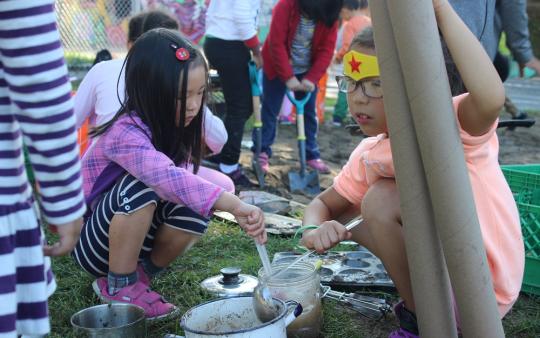My 10-year-old cousin has a circle of school friends who spend their entire recess planning online gaming pursuits. They play against one another each evening and then talk about it the next day, often bringing their gadgets to school. He would rather spend time playing virtually than playing physically, outside, at his local park.
I worry that my cousin may already be suffering from nature-deficit disorder — a term coined by Richard Louv in his book Last Child in the Woods.
His parents are like many others in that they try to get their kids outside on weekends, but from Monday to Friday, they simply rely on the routine of the school day (which includes outdoor recess and lunch) to ensure their children get fresh air and exercise. Unfortunately, a recent report released by ParticipACTION indicates that than 90% of children in Canada ages 5-17 are getting less than 60 minutes of heart-pumping activity each day. Obesity rates among children and youth in Canada have nearly tripled in the last 30 years.
Outdoor classrooms
Thanks to the environmental movement, we’re seeing more and more outdoor classrooms at our schools. These are often cited as a way to get students outside, interacting with nature. But there is immense variation in what an outdoor classroom constitutes. Some will have butterfly gardens, composting units, meditation paths, and an abundance of nature-based elements. In other cases, “outdoor classroom” may involve nothing more than a teacher allowing her students to take their academic work out on the football field on a warm spring day.
While any form of “outdoor classroom” is a good thing — in that it gets kids outside and, generally speaking, tends to boost performance and focus — the problem is that, in most cases, the structure of it is still, well, a classroom: There is one-way instruction from teacher to student, there is set curriculum to be followed, the usual academic obligations and restrictions. Very rarely does an outdoor classroom allow for self-directed play and discovery.
There are a handful of preschools that offer full-day outdoor classrooms and promote free, unstructured playtime; however, it’s rare to see this on offer for kids in Grades 1 and higher.

We need a Recess Renaissance
Regardless of whether a school has an outdoor classroom (in any sense of the term), it can always take a huge step in the right direction by simply allowing more time for recess, and less intervention or micromanagement from school staff in terms of how that time is spent. It’s important to bring back this free time for students and make it actually free again, as it’s often the only chance children have to enjoy unstructured play.
The American Academy of Pediatrics insists that recess is necessary for a child’s development. Quality recess time offers cognitive, social, emotional, and physical benefits — and, for these reasons, no child should be deprived of recess for punitive or academic reasons.
Turning schoolyards into playscapes
Look at most school playgrounds and you’ll see swings, slides, and monkey bars. These fixed playground structures are often low to the ground (i.e. low risk and even lower potential for exciting or stimulating play) and take up maybe 5 to 10% of the total schoolyard, with the remainder being asphalt. There may be a grass field, usually reserved for competitive sports.
During my childhood, I was never interested in games like soccer, football, or basketball. My favourite school play memories are of rolling down a hill and getting dizzy, or of collecting pinecones for my mother, who would put them on display next to her plants. Kids like this today are often left out at recess — you see them hovering around the edges of their schoolyard, sitting on a fence with friends, or picking at stuff on the ground. The play area has become boring to them, they aren’t going to fight for a soccer ball, and there isn’t much else to do.
Where I work, at Earth Day Canada, we have a pilot program that is targeting these kids in particular — it’s called Outdoor Play and Learning (OPAL). First developed and introduced to schools in the UK, it’s been rolled out in six schools here in Toronto with great success. Every single child at every single school is engaged during recess in self-directed play with loose parts (tools, cardboard boxes and tubes, spare tires, rope, water, hay, logs, etc.), moving their bodies, developing their sense of agency and creating a more inclusive environment. They create their own obstacle courses, forts and even cooking stations. I asked one child if the cardboard structure he’d just created was his house and he replied, “Yes, and I’m moving in permanently!”
How to get more outdoor play into your school
1. Learn more about the benefits of unstructured outdoor play with loose parts. Download our handout for parents, which includes advice for how to support better outdoor play at school.
2. Watch this video, which features testimonials from a principal and teacher at one of our OPAL pilot schools, speaking about how the program has changed their students’ behaviour.
3. Request a meeting with your school’s parent council or principal to discuss the research and current play opportunities at your school.
4. Start small, think big! Many issues can affect the richness of your child’s play at school — policies that prevent play in certain weather conditions, restrictions on what kids can play with and where they can play, etc. Choose one area to focus on first (i.e. adding shovels and buckets to an existing sand pit) and let the momentum build from there.
*Originally published May 8, 2017









